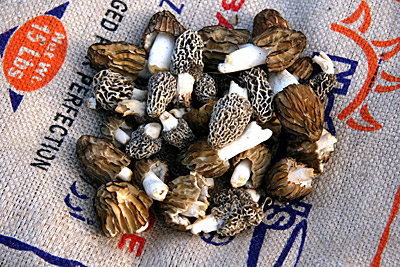The delectable fungi is the first I've spied this season. And it looks like it won't be the last.
"Careful where you step," said Britt Bunyard of Germantown, one of my guides for the afternoon. "They are masters of camouflage."
I've joined Bunyard and Tom Bardenwerper of Thiensville on a mushroom hunting expedition in the Wisconsin spring woods.
I think we were in the Kettle Moraine State Forest - Northern Unit, but I can't be sure. If one finagles an invitation to join morel masters on a fungi hunt, he can expect certain restrictions.
With a rich, nutty flavor, the morel is a delicacy among North American wild foods. The location of prime morel picking spots can be as closely guarded as a bank account password.
Bunyard, 42, is editor and publisher of Fungi magazine and holds a doctorate in mycology. He grew up on a farm in Ohio and has picked morels since he was old enough to walk.
Bardenwerper, 45, is an enthusiastic hunter, angler and forager who grew up tromping the woods of Washington and Ozaukee and Fond du Lac counties.
"You don't have a GPS with you, right?" says Bardenwerper, smiling.
The south-facing slope fairly glows under the mid-afternoon sun. A pair of dead elm trees stands near the edge of the woods, rough sheets of bark peeling away from smooth, gray trunks.
And on the ground below, a dozen or more morels push up into the light. Stooped over and eyes straining, we scour the terrain, breaking off one morel after another and adding them to a burlap bag.
Morels have a multi-faceted appeal. Their wrinkled, hollow fruiting body - sometimes called "sponge on a stick" - is easy to identify.
"It's one of the simplest for beginners to learn and feel comfortable with," said Bunyard, who teaches a mycology course at UW-Washington County. A false morel, which is poisonous, is much less common and has a distinctly different look.
There is also the undeniable fun of a treasure hunt in the Wisconsin spring woods. The legs and lungs can get a workout exploring the woods. Mushroom hunting is also a pathway to learning flora and fauna.
And if successful, the morel hunt provides an all-natural, gastronomic bounty. |
Morel Choices
Easy to identify and great to eat, morels have long been a favorite of hunters and gatherers in Wisconsin.
The fungi are common in the Badger State; among the best places to look are the Northern and Southern units of the Kettle Moraine State Forest. Morels may be hunted free on public lands in Wisconsin. Simply break or cut the stem at ground level and carry the morels in a ventilated sack.
Once collected, Britt Bunyard, editor and publisher of Fungi magazine, recommends lightly brushing the fruit body to remove any dirt. Next slice the morels lengthwise and sauté lightly in butter. The slices may then be eaten as the main event, used as a side dish or added to pizza, salads, pasta or sauces.
Bunyard also likes morels deep-fried in a tempura batter. Mix a batter of ¾ cup rice flour, ¾ cup beer, ½ teaspoon garlic powder, ¾ teaspoon salt and ½ teaspoon baking soda. Whisk the thin mixture until smooth. Then coat the morel slices with the batter and fry.
Wiebke Trading Company in La Crosse buys and sells fresh morels. Fresh morels are selling for about $30 per pound this spring, said Jeff Adamson, a Wiebke spokesman. For more information call (608) 784-4402 or visit www.wiebke.com.
Fungi magazine is published in Richfield by Britt Bunyard. For more information, call (262) 677-0876 or visit www.fungimag.com.
For general mushroom information, including help with species identification, visit www.mushroomexpert.com.
|
|
Depending on whom you ask, there are about 16 species of morels. But the species debate about fungi gets tricky - not to mention morels are not technically mushrooms (they belong to a different phylum).
But that's not so interesting to most hunters. And it's nowhere near as tasty as the fungi.
The morel filling our bag at the moment is called the half cap or half free.
After a half hour, it's back in the pick-up and onto the rolling roads of east central Wisconsin. Bunyard drives in crazy circles. He claims it's because he's looking for morels.
It seems counterintuitive, but he spends most of his morel-scouting time looking at the crowns of trees. That's because the fungi are often found under dead American elm and white ash trees, especially.
But they may also occur along railroad grades, in old apple orchards, rural cemeteries, even near highways.
A slightly profound but largely unhelpful axiom says: Morels are where you find them.
After a 15-minute, circuitous route Bunyard pulls off a rural highway and we hike uphill to mixed stand of pine and elm and maple. Near the base of a dead elm we again find morels - this time a species called the yellow morel.
Our timing is apparently right. "I like to go when the redbuds are blooming," said Bunyard.
Others search for morels when "oak leaves are as big as a squirrel's ear" or "mayapples are blooming."
Aspiring mushroom hunters might want to get out this year. The season, said Bunyard, is shaping up to be one for the record books.
That assessment is shared by Jeff Adamson, a representative of Wiebke Trading Co. in La Crosse, a buyer and seller of fresh morels.
"The supply is fantastic," said Adamson. "From one perspective, it's too good."
Shroomers eyes glaze over when they talk of finding the "field of dreams" - a spot teeming with morels. Will this be the year?
Bardenwerper found one in recent days. It had 100 morels around a single tree. I don't have to tell you - it was after our joint outing.
We found dozens, though, of both the yellow and half caps. The morels were fresh and firm and delicious.
Recent rains and cool temperatures bode well for mushroom hunters. The spring morel season could continue for a couple more weeks in southern Wisconsin.
"Get them while you can," said Bunyard. |














